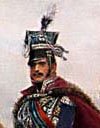Duke Stefanik of Mieczyslaw did not directly involve the Duchy of Mieczyslaw in any of the struggles of the Habsburg Family Conflict. The same cannot be said of many of the families within the Duchy of Mieczyslaw, nor of those adventurers whom chose to raise mercenary companies and 'join the fray'!
One such mercenary commander was Count Gerkik of Coronet, whom marched with the Army of the League under Tilly and was victorious at the Battle of the White Mountain in 1620. By the conclusion of Tilly's campaigns in Heidelburg, Westphalia and Lower Saxony Count Gerkik and the Coronet Korps had become battle-hardened veterans, with many newer drafts coming in from Bohemia, and Saxony. In recognition for these efforts Gerkik was awarded many lands confiscated from Bohemian nobility.
In 1627 another Mieczyslaw mercenary force was assembled by Baron Konrad Owijać-Drewna (of the Windy Woods). These troops were attached to Wallenstein by financial and territorial agreements by the Generalissimo of the Baltic and the Ocean Seas.
Baron Konrad's fortunes did not fare so well, for after the Peace of Lubeck and the Edict of Restitution, Wallenstein was forcibly removed by the Habsburg Princes and all the agreements that the Baron was counting on to enrich his line and secure a place in Mieczyslaw ducal fortunes were erased. The Baron returned a broken man and Owijać-Drewna land were poorer for the loss of so many brave men in the Netherlands.
Count Gerkik of Coronet meanwhile had lost the connection with Tilly, due mostly to the lack of pay for his mercenaries (though the confiscated lands did maintain the Count quite well), Gerkik transferred his flag to the League of Heilbronn, becoming active in field operations again in 1633.
Along with the League under the command of Bernhard of Weimar, Count Gerkik and the Coronet Korps faught for German liberty and the satisfaction of Sweden conquering the Upper Palatinate and Bavaria to the Danube. The Coronet Korps was now taking on a very German character with less than 10% of the troops having remained from the original soldiery that left from the Duchy of Mieczyslaw in 1619. Count Gerkik laid down the command of the Korps and retired to his lands in Bohemia. A new commander, Pułkownik Ludwik, risen from the ranks of those Mieczyslaw veterans took the mantle of command for the Coronet Korps and continued their mercenary connection to the League of Heilbronn until the Peace of Prague in 1635.

Bavarian Prince Elector Maximilian I
Pułkownik Ludwik and the Coronet Korps changed alleigance for the final time in 1636 by tranfer of thier flag to the Bavarian Prince Elector Maximilian I.
Pułkownik Ludwik and the Coronet Korps faught bravely throughout the resumption of the war during the Freanco-Swedish phase, leading to their participation in the battle of Tuttlingen under General Mercy in 1643.
The final action of the Coronet Korps came at Alerheim in 1645 during the pincer attack that ended the war. The Korps was disbanded in 1646, though many of the men and officers continued to support Bavarian Prince Elector Maximilian I. These supports were rewarded in 1648 following the Peace of Westphalia, which saw Bavaria retain the important Upper Palatinate and status as an elector.
The Duchy was rewarded with closer ties to the Holy-Roman Empire again and influence of that court through Bavaria and its elector.
For his part Pułkownik Ludwik was promoted Ogólny and named as Captain-Gracz, Commander of all Duchy of Mieczyslaw forces upon his return to Mieczyslaw!


.jpg)
